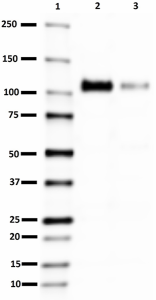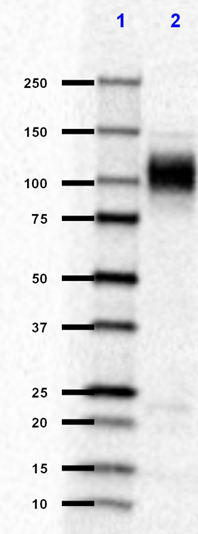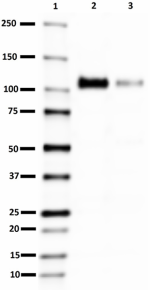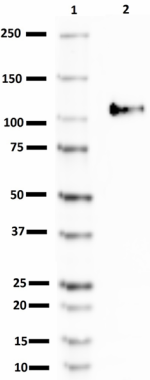- Clone
- Poly8134 (See other available formats)
- Regulatory Status
- RUO
- Other Names
- Amyloid beta A4 protein, preA4, protease nexin-II, peptidase nexin-II, beta-amyloid peptide, alzheimer disease amyloid protein, cerebral vascular amyloid peptide, APP, Amyloid Precursor Protein
- Previously
-
Signet Catalog# 9138-005
Covance Catalog# SIG-39138
- Isotype
- Rabbit Polyclonal IgG
- Ave. Rating
- Submit a Review
- Product Citations
- publications

-

Western blot of purified anti-sAPPβ antibody (Poly8134). Lane 1: Molecular weight marker; Lane 2: 20 µg of Alzheimer's disease human brain lysate; Lane 3: 20 µg of normal human brain lysate. The blot was incubated with 1 µg/mL of the primary antibody overnight at 4°C, followed by incubation with HRP labeled goat anti-rabbit IgG (Cat. No. 410406). Enhanced chemiluminescence was used as the detection system. -

Western blot of purified anti-sAPPβ antibody (Poly8134). Lane 1: Molecular weight marker; Lane 2: 20 µg of human cerebrospinal fluid (CSF). The blot was incubated with 1 µg/mL of the primary antibody overnight at 4°C, followed by incubation with HRP labeled goat anti-rabbit IgG (Cat. No. 410406). Enhanced chemiluminescence was used as the detection system.
| Cat # | Size | Price | Quantity Check Availability | Save | ||
|---|---|---|---|---|---|---|
| 813401 | 50 µg | 654 CHF | ||||
APP (Amyloid Precursor Protein) is a single-pass type I membrane protein expressed in all fetal tissues examined with highest levels in brain, kidney, heart and spleen, and with weak expression in liver. In adult brain, highest expression found in the frontal lobe of the cortex and in the anterior perisylvian cortex-opercular gyri. Moderate expression in the cerebellar cortex, the posterior perisylvian cortex-opercular gyri and the temporal associated cortex. Weak expression is found in the striate, extra-striate and motor cortices. Expressed in cerebrospinal fluid, and plasma. Isoform APP695 is the predominant form in neuronal tissue, isoform APP751 and isoform APP770 are widely expressed in non-neuronal cells. Isoform APP751 is the most abundant form in T-lymphocytes. Appican is expressed in astrocytes.
APP functions as a cell surface receptor and performs physiological functions on the surface of neurons relevant to neurite growth, neuronal adhesion and axonogenesis. Involved in cell mobility and transcription regulation through protein-protein interactions. Cleavage either by alpha-secretase, beta-secretase or theta-secretase leads to generation and extracellular release of soluble APP peptides, S-APP-alpha and S-APP-beta, and the retention of corresponding membrane-anchored C-terminal fragments, C80, C83 and C99. Subsequent processing of C80 and C83 by gamma-secretase yields P3 peptides. This is the major secretory pathway and is non-amyloidogenic. Alternatively, presenilin/nicastrin-mediated gamma-secretase processing of C99 releases the amyloid beta proteins, amyloid-beta 40 (Abeta40) and amyloid-beta 42 (Abeta42), major components of amyloid plaques, and the cytotoxic C-terminal fragments, gamma-CTF(50), gamma-CTF(57) and gamma-CTF(59). Many other minor beta-amyloid peptides, beta-amyloid 1-X peptides, are found in cerebral spinal fluid (CSF) including the beta-amyloid X-15 peptides, produced from the cleavage by alpha-secretase and all terminating at Gln-686. It is proteolytically cleaved by caspases during neuronal apoptosis. Cleavage at Asp-739 by either caspase-6, -8 or -9 results in the production of the neurotoxic C31 peptide and the increased production of beta-amyloid peptides.
Product Details
- Verified Reactivity
- Human, Mouse, Rat
- Antibody Type
- Polyclonal
- Host Species
- Rabbit
- Formulation
- Phosphate-buffered solution (no preservatives or carrier proteins).
- Preparation
- The antibody was purified by affinity chromatography.
- Concentration
- 1.0 mg/ml
- Storage & Handling
- Do not store antibody diluted below 50 µg/mL in the absence of protein (i.e. add 2% bovine serum albumin). The antibody solution should be stored undiluted between 2°C and 8°C. Please note the storage condition for this antibody has been changed from -20°C to between 2°C and 8°C. You can also check your vial or your CoA to find the most accurate storage condition for this antibody.
- Application
-
WB - Quality tested
- Recommended Usage
-
Each lot of this antibody is quality control tested by Western blotting. For Western blotting, the suggested use of this reagent is 1 - 2 µg per ml. It is recommended that the reagent be titrated for optimal performance for each application.
- Application Notes
-
This antibody is specific for the soluble fragment cleaved n-terminus to the beta secretase cleavage site of amyloid precursor protein. It has neglible cross reactivity to sAPPa or full length APP.
This product may contain other non-IgG subtypes. -
Application References
(PubMed link indicates BioLegend citation) -
- Freude, Kristine K., et al. Soluble Amyloid Precursor Protein Induces Rapid Neural Differentiation of Human Embryonic Stem Cells. J. Biol. Chem.:286(27): 24264 - 24274, Jul 2011. (WB) PubMed
- Ellen Jorissen, et al. The Disintegrin/Metalloproteinase ADAM10 Is Essential for the Establishment of the Brain Cortex. J. Neurosci.: 30(14): 4833 - 4844, Apr 2010. (WB) PubMed
- Qiu-Lan Ma, MD, PhD, et al. Reduction of SorLA/LR11, a Sorting Protein Limiting beta-Amyloid Production, in Alzheimer Disease Cerebrospinal Fluid. Arch Neurol:66(4): 448-457, Apr 2009. (WB) PubMed
- Corbett GT, et al. 2015. PNAS. PubMed
- Product Citations
-
- RRID
-
AB_2564769 (BioLegend Cat. No. 813401)
Antigen Details
- Biology Area
- Cell Biology, Neurodegeneration, Neuroscience, Protein Misfolding and Aggregation
- Molecular Family
- APP/β-Amyloid
- Gene ID
- 351 View all products for this Gene ID
- UniProt
- View information about sAPPbeta on UniProt.org
Related Pages & Pathways
Pages
Other Formats
View All sAPPβ Reagents Request Custom Conjugation| Description | Clone | Applications |
|---|---|---|
| Purified anti-sAPPβ | Poly8134 | WB |
Customers Also Purchased

Compare Data Across All Formats
This data display is provided for general comparisons between formats.
Your actual data may vary due to variations in samples, target cells, instruments and their settings, staining conditions, and other factors.
If you need assistance with selecting the best format contact our expert technical support team.
 Login / Register
Login / Register 

















Follow Us